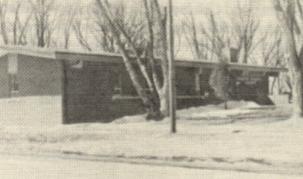HOOKER COUNTY LIBRARY - MULLEN
by Mary Lou Schenck
Entry T21 from the History of Hooker County Nebraska
with permission of the Hooker County Historical Society

Hooker County Library - Early 1970's
The Ladies Welfare Club of Mullen spon-
sored a movement for a public library in 1920,
and by 1923 they were given permission to use
a room in the court house. In May of 1924,
there were 756 books in the collection, and
soon the need for more room became evident.
After the circulation of a petition, a general
election was held in Hooker County in Nov.,
1930; the question of establishing a county
library was voted on, passing by a margin of
267-239. The commissioners appointed a
library board of 5 members: A. G. Humphrey
(president), W.H. Wigent, Eva Lowe (secre-
tary), W.L. Goggin, and Myrtle Senk. The
board then proceeded with plans to build a
26 foot x 36 foot basement on the northwest
corner of the court house block, covered with
a roof, the intention being to complete the
building at a later date. The low bid of
$482.32 was submitted by Frank Fitzgerald.
By July of 1935, the basement had sufficient-
ly dried, and 2800 volumes were moved.
In 1962 the Nebr. Library Association in
Lincoln began a state plan for regional
organization of libraries. The development of
Thomas County Library was begun in 1962,
and by 1965 it was serving eastern Cherry,
Blaine, and Thomas Counties with bookmob-
ile service. Then Thomas County Library
demonstrated bookmobile service in Hooker
and McPherson Counties for a 2 yr. period,
paid with state funds. In order to improve
library service in the area, it was anticipated
that by 1966 Hooker County Library would
have a bookmobile in operation.
The library board in 1965 was: Josephine
Humphrey (president), Sarah Bramer (secre-
tary), Wayne Fitzgerald, Ellis Jacobs, and
Nellie Johnston. The board worked with the
Nebr. Library Commission consultants
Frank Gibson and Jane Pope. Their plan was
to take advantage of the Federal Library
Services and Construction Act in order to
receive matching funds of $25,000 for a new
library and an additional $5,000 for equip-
ment and books. The new library was to be
located on the southeast corner of the court
house block. In August of 1965 an injuction
was filed in the district court for a restraining
order to prevent construction. The judge gave
permission for the erection of the building,
ruling that the library board reported an-
nually to the commissioners and that there
was sufficient money on hand because of
previous planning. A letting was later held in
August. The 65 foot x 32 foot brick building
was completed in the spring of 1966 - Open
House was held June 25th.
Dewey Decimal cataloging of the 3967 book
collection was begun in 1964. Many of the
older books had to be discarded because of
mold and oil-fume permeation. Each book
that was cataloged had to be opened, sprayed,
and aired. By the time the new building was
completed, 3934 new books had been added,
and the Library Commission sent another
4219 books on long-term loan. By Sept. 1966
we began our bookmobile demonstration to
15 rural schools in Hooker, southwestern
Cherry, and McPherson Counties. At the
request of their commissioners, we started
another demonstration in Sheridan County
in 1970. At the end of each demonstration
period, the county being served contracted
with our library, paying all expenses. The
bookmobile we had was the first vehicle that
had been used for this purpose in the state,
and it was a gift to us. By 1970 we were able
to purchase a new bookmobile, paid with
funds set aside from each county participa-
tion; it was in operation until 1980. At that
time, we sold the vehicle because of increas-
ing costs and lack of long-term contract
renewals.
The January 1987 records show a book
collection of 16,094 volumes. We also have
paperbacks, records, cassettes, 8-track tapes,
film strips, and slide, movie, and filmstrip
projectors. The basement is used for Story
Hour and community meetings. We also have
a microfiche reader which enables us to use
the state interlibrary loan system; we fill
many requests for books and also audiovisual
materials, including videocassettes.
